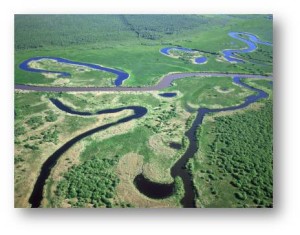By Gavin Roy
 Human interaction with rivers began thousands of years ago when organized agriculture first appeared, and the interaction continues today on a grand scale. Rivers are diverted for irrigation, contained by concrete barriers through major cities, and dammed to form reservoirs and generate hydroelectric power. As humans rely on the Earth’s rivers more every year, however, our vulnerability to floods and droughts also increases.
Human interaction with rivers began thousands of years ago when organized agriculture first appeared, and the interaction continues today on a grand scale. Rivers are diverted for irrigation, contained by concrete barriers through major cities, and dammed to form reservoirs and generate hydroelectric power. As humans rely on the Earth’s rivers more every year, however, our vulnerability to floods and droughts also increases.
The worldwide PAGES (Past Geological Changes) Organization has formed a task force to investigate this increasing vulnerability. Called LUCIFS (Land Use and Climate Impact on Fluvial Systems), this committee hopes to enhance our understanding of the way that rivers change over time. By doing so, we can better understand how humans will be affected.
A recent study by LUCIFS, spearheaded by Dr. Thomas Hoffmann of the University of Bonn in Bonn, Germany, advises looking toward the past in order to be able to understand what will happen in the future. By sampling historic floodplains and fluvial basins, where rivers empty into larger bodies of water, scientists can determine what sediments were carried where by which rivers. From this, they can then begin to determine how the river’s course has changed over time as well as the magnitude of past floods.
One example of this application is from the River Till in northern England, which flooded to historic levels in September of 2008 and in many places exceeded levee heights by over a meter. Post-flood analysis of bedrock alongside the river as well as sediment deposits downstream showed evidence of historic floods over a meter higher than even this flood. If this information had been known prior to the levees’ construction, it is likely that the economic loss from the ’08 River Till Flood could have been avoided by a simple two meters’ extension in levee height.
Of course, detection of historic flood levels is not always so easy. Rivers meander over time, and eroding soil carries away records of past sediment deposits. LUCIFS looks to find new and innovative ways to approach these challenges. These techniques include GIS satellite analysis, sediment budget “balancing”, and scenario-based modeling to mimic future flood scenarios. As is the case with most geological interactions, Hoffman et al. point out that precise results should not be expected; rather general trends will be established. By examining and understanding these trends, scientists will be better able to inform engineers and politicians of what to expect in the future with regards to river management.
With an ever-growing quantity of data and computing power, the ability to safely harness the power of rivers is becoming increasingly feasible. While flood prediction years or even months in advance may forever remain impossible, it is the hope of LUCIFS that humans will at least be ready to face the effects of changing rivers.
Source: Article on past human impacts on rivers by the PAGES-LUCIFS group
LUCIFS (Land Use and Climate Impact on Fluvial Systems) group’s review of ‘Human impact on fluvial regimes and sediment flux during the Holocene: Review and future research agenda’ has been accepted for publication in Global and Planetary Change.
http://www.pages-igbp.org/cgi-bin/WebObjects/products.woa/wa/product?id=442

Comments are closed.